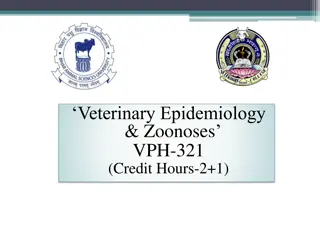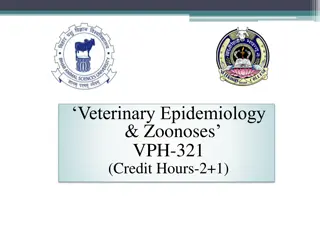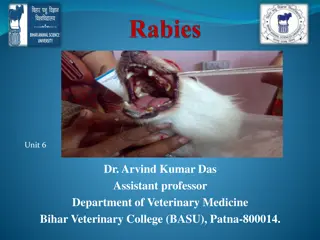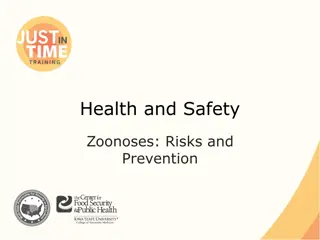
Rabies: Causes, Transmission, and History
Discover the ins and outs of rabies, from its causes and transmission to historical milestones like Pasteur's contributions. Learn how this disease impacts both humans and animals, and explore methods of diagnosis and cure. Dive into the world of rabies with this comprehensive seminar submission.
Download Presentation

Please find below an Image/Link to download the presentation.
The content on the website is provided AS IS for your information and personal use only. It may not be sold, licensed, or shared on other websites without obtaining consent from the author. If you encounter any issues during the download, it is possible that the publisher has removed the file from their server.
You are allowed to download the files provided on this website for personal or commercial use, subject to the condition that they are used lawfully. All files are the property of their respective owners.
The content on the website is provided AS IS for your information and personal use only. It may not be sold, licensed, or shared on other websites without obtaining consent from the author.
E N D
Presentation Transcript
www.studymafia.org Seminar On Rabies Submitted To: www.studymafia.org www.studymafia.org Submitted By:
Content What are Rabies? How is Rabies spread? History Pasteur s Contribution Epidemiology Rabies Diagnosis in Humans Methods of Cure
What are Rabies? Rabies virus causes an acute encephalitis (inflammation of the brain) in all warm-blooded hosts. Rabies is not, in the natural sense, a disease of humans. The impact of rabies on public health includes an estimate of the animal population that is affected and the steps involved in preventing transmission of rabies from animals to humans. Raccoons, skunks, foxes, coyotes, and several species of insectivorous bats have been identified as reservoirs for the disease.
How is Rabies spread? Rabies is transmitted through the saliva of an infected animal. This usually occurs by a bite wound. The virus then travels up the nerves toward the brain and spinal cord. It even leaves one nerve cell and moves to the next. How do you suppose it does that?
Rabies in History Rabies cases have been reported since before 2300 BC. 1st century AD a Roman scholar named Aulus Cornelius Celsus gave the first accurate description of the disease 1st scientist to test rabies infection through inoculation of saliva was a German scientist named Zinke in 1804
Pasteurs Contribution 1885 he published a method for protecting dogs against rabies A dog exposed to rabies was protected by inoculation with an emulsion prepared from the dried spinal cord of a diseased rabbit Pasteur had the chance to test this same method on humans when Joseph Meister, a nine-year-old boy who was bitten by a rabid dog was brought to him in July of 1885
Joseph was injected over several days with the emulsions prepared from animal spinal cord material After 2 weeks, Joseph was given an injection of virus that had maximal virulence when tested in a rabbit Joseph survived as did thousands of others treated by the same procedure.
Epidemiology In 2001, 49 states, the District of Colombia, and Puerto Rico reported 7,437 cases of rabies in animals to the Center of Disease Prevention and Control and no cases in humans were reported. Pennsylvania reported the largest number of rabid domestic animals (46) for any state, followed by New York (43) The number of rabies-related human deaths in the U.S. has declined from 100 or more each year at the turn of the century to an average of 1-2 each year in the 1990 s
Morphology Order- Mononegavirales Nonsegmented Negative stranded RNA genome Bullet shaped- Rhabdovirus 180nm x75nm 400 trimeric spikes on surface of virus 2 major structural components Helical RNP core Surrounding envelope
Physiology Genome encodes 5 proteins: Nucleoprotein- encases RNA Phosphoprotein- associated with ribonuceoprotein core Matrix protein- central protein of rhabdovirus assembly Glycoprotein- forms 400 trimeric spikes Polymerase- transcribes genomic strand of rabies RNA
Virulence Depends on severity of bite If treatment is given and when Once the disease manifests in CNS: ultimate death
Pathogenicity Defined by encephalitis and myelitis Perivascular infiltration throughout entire central nervous system Causes cytoplasmic eosinophilic inclusion bodies (Negri bodies) in neuronal cells Several factors may affect outcome of rabies exposure. Rabies variant Dose Route Location of exposure Individual host factors
Transmission Begins when infected saliva of host is passed to uninfected animal. Scratches Bites
Discharge and Intermediate Hosts Infection of new host via saliva Death of host Wild rabid animals may infect domestic animals/people Cattle, horses, pigs, dogs, cats Humans Rabid domestic animals may infect humans
Vehicles of Transmission Saliva Mucous membranes Aerosol transmission Corneal transplantations
Symptoms of Rabies The first symptoms of rabies may be non-specific flu- like signs, such as malaise, fever or headache which may last for days. There may be discomfort or paresthesia at the site of exposure (bite) progressing within days to symptoms of cerebral dysfunction, anxiety, confusion, and agitation which eventually progress to delirium, abnormal behavior, hallucinations, and insomnia.
Rabies Diagnosis in animals The direct fluorescent antibody test (dFA) is the test most frequently used to diagnose rabies. This test requires brain tissue from animals suspected of being rabid. The dFA test is based on the fact that infected animals have rabies virus proteins (antigen) present in their tissues. Positive dFA Negative dFA
Rabies Diagnosis in humans Saliva can be tested by virus isolation or reverse transcription by polymerase chain reaction (RT- PCR). Serum and spinal fluid are tested for antibodies to rabies virus. Skin biopsy specimens are examined for rabies antigen in the cutaneous nerves at the base of hair follicles.
Methods of Cure Rabies Vaccine: A killed virus vaccine (Human Diploid Cell Vaccine, HDCV) grown in human fibroblasts is available for safe use in humans. The unusually long incubation period of the virus permits the effective use of active immunization with vaccine post-exposure. If rabies has not been diagnosed and the victim is not treated with a vaccine and the clinical disease manifests, it is nearly always fatal, and treatment is typically supportive.
Reference www.google.com www.wikipedia.com www.studymafia.org






















